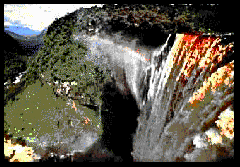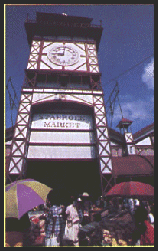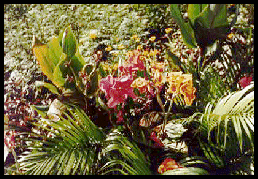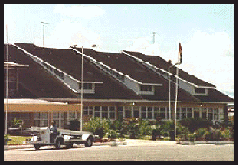




 |
Kaieteur Falls is known as one of the natural wonders of the world. Kaieteur Falls was first discoverd on April 29,1870 by Charles Barrington Brown. Kaieteur Falls is located on the Potaro River, a tributary of the Essequibo River. |
| Kaieteur Falls is 741 feet high, which is five times the height of Niagara Falls. There are no other falls in the world with a magnitude or sheer drop existing at Kaieteur. The width of the falls varies from 250 feet in the dry season and 400 feet at the height of the wet season. The Amerindian legend of the Patomona tribe has it that Kaie, one of the tribe's great old chieftains, after whom Kaieteur is named, committed self-sacrifice by canoeing himself over the falls in order that Makonaima, the great spirit, would save the tribe from being destroyed by the savage Caribisi. |
 |
| Kaieteur Falls 1 | Kaieteur Falls 2 |
| Kaieteur Falls 3 | Kaieteur Falls 4 |
| Kaieteur Falls 5 | Kaieteur Falls 6 |
| Kaieteur Falls 7 | Kaieteur Falls 8 |
| Kaieteur Falls 9 | Kaieteur Falls 10 |
| Kaieteur Falls 11 | Kaieteur Falls 12 |

Stabroek Market is located on Water Street, Georgetown. It was administered by the City Council and is built entirely of cast iron and extends into the Demerara River. Opened to the public since 1881, it lives up to its reputation of having anything, from a pin to an anchor for sale.

The Botanic Gardens is one of Georgetown's popular recreation parks. In 1877, Government voted $72,000 to establish the Gardens, and John Frederick Waby, the first gardener, arrived in Georgetown in December 1878. He spent 35 years in Guyana landscaping one of the finest tropical gardens in the region. These gardens have a huge variety of tropical flowers and one of the finest collection of palms, as well as lovely lilies. An example of the gardens vast are the lotus and the immense Victoria Regia Lily, Guyana's national flower, which was first discovered in the Berbice River.

Timehri International Airport is on the right bank of the Demerara River, 26 miles south of Georgetown, the capital. The word Timehri means "Rock Painting" and is the name given to the rock paintings or engravings found in the interior of Guyana, particularly near falls and rapids. Legend has it that the Timehri art was the work of the Amerindian folklore god "Amalivacar", who visited Guyana at the time of the flood. Anthropologists, however, consider that the paintings date back to the 14th century. A mural done in the Timehri Motif by famous Guyanese artist, the late Aubrey Williams, adorns the outer wall of the airport's V.I.P. Lounge.




